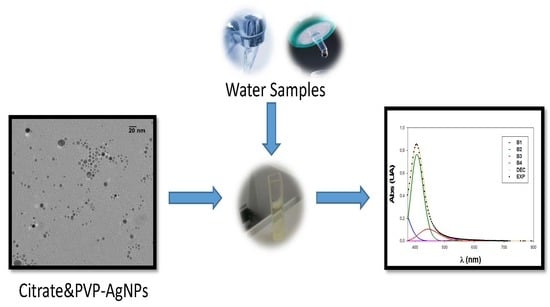Citrate and Polyvinylpyrrolidone Stabilized Silver Nanoparticles as Selective Colorimetric Sensor for Aluminum (III) Ions in Real Water Samples
Abstract
1. Introduction
2. Materials and Methods
2.1. Chemicals
2.2. Apparatus
2.3. Silver Nanoparticles Synthesis
2.3.1. Synthesis of PVP-AgNPs
2.3.2. Synthesis of NaBH4-AgNPs
2.3.3. Synthesis of Citrate-AgNPs
2.3.4. Synthesis of Citrate+PVP-AgNPs
3. Results and Discussion
3.1. AgNPs Characterization
3.2. Interaction of AgNPs with Metal Ions
3.2.1. Effect of Medium pH
3.2.2. Influence of Aluminum Concentration
3.3. Deconvolution of Spectra Citrate+PVP-AgNPs:Al
3.4. Analytical Study of the Citrate+PVP-AgNPs:Al Interaction
3.5. Real Water Samples Analysis
4. Conclusions
Author Contributions
Funding
Acknowledgments
Conflicts of Interest
References
- Baylor, W.; Egan, W.; Richman, P. Aluminum salts in vaccines-US perspective. Vaccine 2002, 20, S18–S23. [Google Scholar] [CrossRef]
- Soni, M.G.; White, S.M.; Flamm, W.G.; Burdock, G.A. Safety evaluation of dietary aluminum. Regul. Toxicol. Pharm. 2001, 33, 66–79. [Google Scholar] [CrossRef] [PubMed]
- Lee, J.; Kim, H.; Kim, S.; Noh, J.Y.; Song, E.J.; Kim, C.; Kim, J. Fluorescent dye containing phenol-pyridyl for selective detection of aluminum ions. Dye. Pigment. 2013, 96, 590–594. [Google Scholar] [CrossRef]
- Liu, X.; Wu, F.; Ma, L. Colorimetric assay for Al3+ based on alizarin red S-functionalized silver nanoparticles. Aust. J. Chem. 2014, 67, 1700–1705. [Google Scholar] [CrossRef]
- Banks, W.A.; Kastin, A.J. Aluminum-induced neurotoxicity: Alterations in membrane function at the blood-brain barrier. Neurosci. Biobehav. Rev. 1989, 13, 47–53. [Google Scholar] [CrossRef]
- Good, P.F.; Olanow, C.W.; Perl, D.P. Neuromelanin-containing neurons of the substantia nigra accumulate iron and aluminum in parkinson’s disease: A LAMMA study. Brain Res. 1992, 593, 343–346. [Google Scholar] [CrossRef]
- Paik, S.R.; Lee, J.H.; Kim, D.H.; Chang, C.S.; Kim, J. Aluminum-induced structural alterations of the precursor of the non-Aβ component of alzheimer’s disease amyloid. Arch. Biochem. Biophys. 1997, 344, 325–334. [Google Scholar] [CrossRef]
- Lin, J.L.; Kou, M.T.; Leu, M.L. Effect of long-term low-dose aluminum-containing agents on hemoglobin synthesis in patients with chronic renal insufficiency. Nephron 1996, 74, 33–38. [Google Scholar] [CrossRef]
- ATSDR. Toxicological Profile for Aluminium; US Department of Health and Human Services, Public Health Service, Agency for Toxic Substances and Disease Registry: Atlanta, GA, USA, 1992.
- WHO. Health criteria and other supporting information. In Guidelines for Drinking-Water Quality, 2nd ed.; World Health Organization: Geneva, Switzerland, 1998; Volume 2. [Google Scholar]
- Kaur, A.; Raj, T.; Kaur, S.; Kaur, N. Nano molar detection of Al3+ in aqueous medium and acidic soil using chromone based fluorescent organic nanoparticles (FONPs). Anal. Methods 2014, 6, 8752–8759. [Google Scholar] [CrossRef]
- Gupta, V.K.; Singh, A.K.; Kumawat, L.K. Thiazole Schiff base turn-on fluorescent chemosensor for Al3+ ion. Sens. Actuators B 2014, 195, 98–108. [Google Scholar] [CrossRef]
- Deschaume, O.; Fournier, A.; Shafranab, K.L.; Perry, C.C. Interactions of aluminium hydrolytic species with biomolecules. New J. Chem. 2008, 32, 1346–1356. [Google Scholar] [CrossRef]
- Gupta, V.K.; Goyal, R.N.; Jain, A.K.; Sharma, R.A. Aluminium (III)-selective PVC membrane sensor based on a schiff base complex of N,N’-bis (salicylidene)-1,2-cyclohexanediamine. Electrochim. Acta 2009, 54, 3218–3224. [Google Scholar] [CrossRef]
- Shervedani, R.K.; Rezvaninia, Z.; Sabzyan, H.; Boeini, H.Z. Characterization of gold-thiol-8-hydroxyquinoline self-assembled monolayers for selective recognition of aluminum ion using voltammetry and electrochemical impedance spectroscopy. Anal. Chim. Acta 2014, 825, 34–41. [Google Scholar] [CrossRef] [PubMed]
- Satiroglu, N.; Tokgoz, I. Cloud point extraction of aluminum (III) in water samples and determination by electrothermal atomic absorption spectrometry, flame atomic absorption spectrometry and UV-visible spectrophotometry. Int. J. Environ. Anal. Chem. 2010, 90, 560–572. [Google Scholar] [CrossRef]
- Nagaoka, M.H.; Maitani, T. Speciation of Aluminium in Human Serum Investigated by HPLC/High Resolution Inductively Coupled Plasma Mass Spectrometry (HR-ICP-MS): Effects of Sialic Acid Residues of the Carbohydrate Chain on the Binding Affinity of Aluminium for Transferrin. J. Health Sci. 2009, 55, 161–168. [Google Scholar] [CrossRef][Green Version]
- Chen, S.; Fang, Y.M.; Xiao, Q.; Li, J.; Li, S.B.; Chen, H.J.; Sun, J.J.; Yang, H.H. Rapid visual detection of aluminium ion using citrate capped gold nanoparticle. Analyst 2012, 137, 2021–2023. [Google Scholar] [CrossRef]
- Gupta, V.K.; Singh, A.K.; Ganjali, M.R.; Norouzi, P.; Faridbod, F.; Mergu, N. Comparative study of colorimetric sensors based on newly synthesized schiff bases. Sens. Actuators B Chem. 2013, 182, 642–651. [Google Scholar] [CrossRef]
- Sung, H.K.; Oh, S.Y.; Park, C.; Kim, Y. Colorimetric detection of Co2+ ion using silver nanoparticles with spherical, plate, and rod shapes. Langmuir 2013, 29, 8978–8982. [Google Scholar] [CrossRef]
- Shang, Y.; Wu, F.; Qi, L. Highly selective colorimetric assay for nickel ion using N-acetyl-L-cysteine-functionalized silver nanoparticles. J. Nanopart. Res. 2012, 14, 1169. [Google Scholar] [CrossRef]
- Bothra, S.; Solanki, J.N.; Sahoo, S.K. Functionalized silver nanoparticles as chemosensor for pH, Hg2+ and Fe3+ in aqueous medium. Sens. Actuators B 2013, 188, 937–943. [Google Scholar] [CrossRef]
- Kumar, V.V.; Anbarasan, S.; Christena, L.R.; SaiSubramanian, N.; Anthony, S.P. Bio-functionalized silver nanoparticles for selective colorimetric sensing of toxic metal ions and antimicrobial studies. Spectrochim. Acta Part A Mol. Biomol. Spectrosc. 2014, 129, 35–42. [Google Scholar] [CrossRef]
- Gao, Y.X.; Xin, J.W.; Shen, Z.Y.; Pan, W.; Li, X.; Wu, A.G. A new rapid colorimetric detection method of Mn2+ based on tripolyphospfate modified silver nanoparticles. Sens. Actuators B 2013, 181, 288–293. [Google Scholar] [CrossRef]
- Chen, Z.; Huang, Y.; Li, X.; Zhou, T.; Ma, H.; Qiang, H.; Liu, Y. Colorimetric detection of potassium ions using aptamer-functionalized gold nanoparticles. Anal. Chim. Acta 2013, 787, 189–192. [Google Scholar] [CrossRef] [PubMed]
- Amanulla, B.; Perumal, K.N.; Ramaraj, S.K. Chitosan functionalized gold nanoparticles assembled on sulphur doped graphitic carbón nitride as a new platform for colorimetric detection of trace Hg2+. Sens. Actuators B Chem. 2019, 281, 281–287. [Google Scholar] [CrossRef]
- Chen, Y.; Lee, I.; Sung, Y.; Wu, S. Colorimetric detection of Al3+ using triazole-ether functionalized gold nanoparticles. Talanta 2013, 117, 70–74. [Google Scholar] [CrossRef] [PubMed]
- Rastogi, L.; Dash, K.; Ballal, A. Selective colorimetric/visual detection of Al3+ in ground water using ascorbic acid capped gold nanoparticles. Sens. Actuators B Chem. 2017, 248, 124–132. [Google Scholar] [CrossRef]
- Yang, N.; Gao, Y.; Zhang, Y.; Shen, Z.; Wu, A. A new rapid colorimetric detection method of Al3+ with high sensitivity and excellent selectivity based on new mechanism of aggregation of smaller etched silver nanoparticles. Talanta 2014, 22, 272–277. [Google Scholar] [CrossRef]
- Liu, X.; Shao, C.; Chen, T.; He, Z.; Du, G. Stable silver nanoclusters with aggregation-induced emission enhancement for detection of aluminum ion. Sens. Actuators B Chem. 2019, 278, 181–189. [Google Scholar] [CrossRef]
- Perinot, A.; Kshirsagar, P.; Malvindi, M.A.; Pompa, P.P.; Fiammengo, R.; Caironi, M. Direct-written polymer field-effect transistors operating at 20 MHz. Sci. Rep. 2016, 6, 1–9. [Google Scholar] [CrossRef]
- Kshirsagar, P.; Sangaru, S.S.; Brunetti, V.; Malvindi, M.A.; Pompa, P.P. Synthesis of fluorescent metal nanoparticles in aqueous solution by photochemical reduction. Nanotechnology 2014, 25, 1–12. [Google Scholar] [CrossRef]
- Zhang, Z.; Zhang, H. Controllable synthesis of silver nanoparticles in hyperbranched macromolecule templates for printed flexible electronics. RSC Adv. 2015, 5, 17931–17937. [Google Scholar] [CrossRef]
- Prado-Gotor, R.; López-Pérez, G.; Martín, M.J.; Cabrera-Escribano, F.; Franconetti, A. Use of gold nanoparticles as crosslink agent to form chitosan nanocapsules: Study of the direct interaction in aqueous solutions. J. Inorg. Bichem. 2014, 135, 77–85. [Google Scholar] [CrossRef] [PubMed]
- López-Pérez, G.; Prado-Gotor, R.; Fuentes-Rojas, J.A.; Martin-Valero, M.J. Understanding gold nanoparticles interactions with chitosan: Crosslinking agents as novel strategy for direct covalent immobilization of biomolecules on metallic surfaces. J. Mol. Liq. 2020, 302, 112381. [Google Scholar] [CrossRef]
- Wang, H.S.; Qiao, X.L.; Chen, J.G.; Wang, X.J.; Ding, S.Y. Mechanism of PVP in the preparation of silver nanoparticles. Mater. Chem. Phys. 2005, 94, 449–453. [Google Scholar] [CrossRef]
- Van Dong, P.; Ha, C.H.; Binh, L.T.; Kasbohm, J. Chemical synthesis and antibacterial activity of novel-shaped silver nanoparticles. Int. Nano Lett. 2012, 1, 2–9. [Google Scholar] [CrossRef]
- Fang, J.; Zhong, C.; Mu, R. The study of deposited silver particulate films by simple method for efficient SERS. Chem. Phys. Lett. 2005, 401, 271–275. [Google Scholar] [CrossRef]
- Molero-Casado, M.; González-Arjona, D.; Calvente-Pacheco, J.J.; López-Pérez, G. Activity Coefficients of Al(ClO4)3 in Aqueous Solutions: A Reexamination. J. Electroanal. Chem. 1999, 460, 100–104. [Google Scholar] [CrossRef]
- Sevilla, J.M.; Dominguez, M.; García-Blanco, F.; Blázquez, M. Reolution of absorption spectra. Comput. Chem. 1989, 13, 197–300. [Google Scholar] [CrossRef]
- González-Arjona, D. DECOUVIS; Dpto. de Química Física, Universidad de Sevilla: Sevilla, Spain, 1995. [Google Scholar]
- Cuadros, L.; García, A.M.; Bosque, J.M. Statistical estimation of linear calibration range. Anal. Lett. 1996, 29, 1231–1239. [Google Scholar] [CrossRef]
- Compañó, I.; Beltrán, R.; Ríos Castro, A. Garantía de Calidad en los Laboratorios Analíticos; Síntesis: Madrid, Spain, 2002. [Google Scholar]
- AOAC Official Methods Program Manual, Part 6: Guidelines for Collaborative Study. 2013. Available online: http://www.aoac.org/ (accessed on 11 February 2020).
- Zhou, T.; Lin, L.; Rong, M.; Jiang, Y.; Chen, X. Silver-gold alloy nanoclusters as a fluorescence-enhanced probe for aluminum ion sensing. Anal. Chem. 2013, 85, 9839–9844. [Google Scholar] [CrossRef]
- Huang, P.; Li, J.; Liu, X.; Wu, F. Colorimetric determination of aluminum (III) based on the aggregation of Schiff base-functionalized gold nanoparticles. Microchim. Acta 2016, 183, 863–869. [Google Scholar] [CrossRef]
- Shinde, S.; Kim, D.-Y.; Saratale, R.G.; Syed, A.; Ameen, F.; Ghodake, G. A spectral probe for detection of aluminum (III) ions using Surface functionalized gold nanoparticles. Nanomaterials 2017, 7, 287. [Google Scholar] [CrossRef] [PubMed]
- Shang, Y.; Gao, D.; Wu, F.; Wan, X. Silver nanoparticles capped with 8-hydroxyquinoline-5-sulfonate for the determination of trace aluminum in water samples and for intracellular fluorescence imaging. Microchim. Acta 2013, 180, 1317–1324. [Google Scholar] [CrossRef]

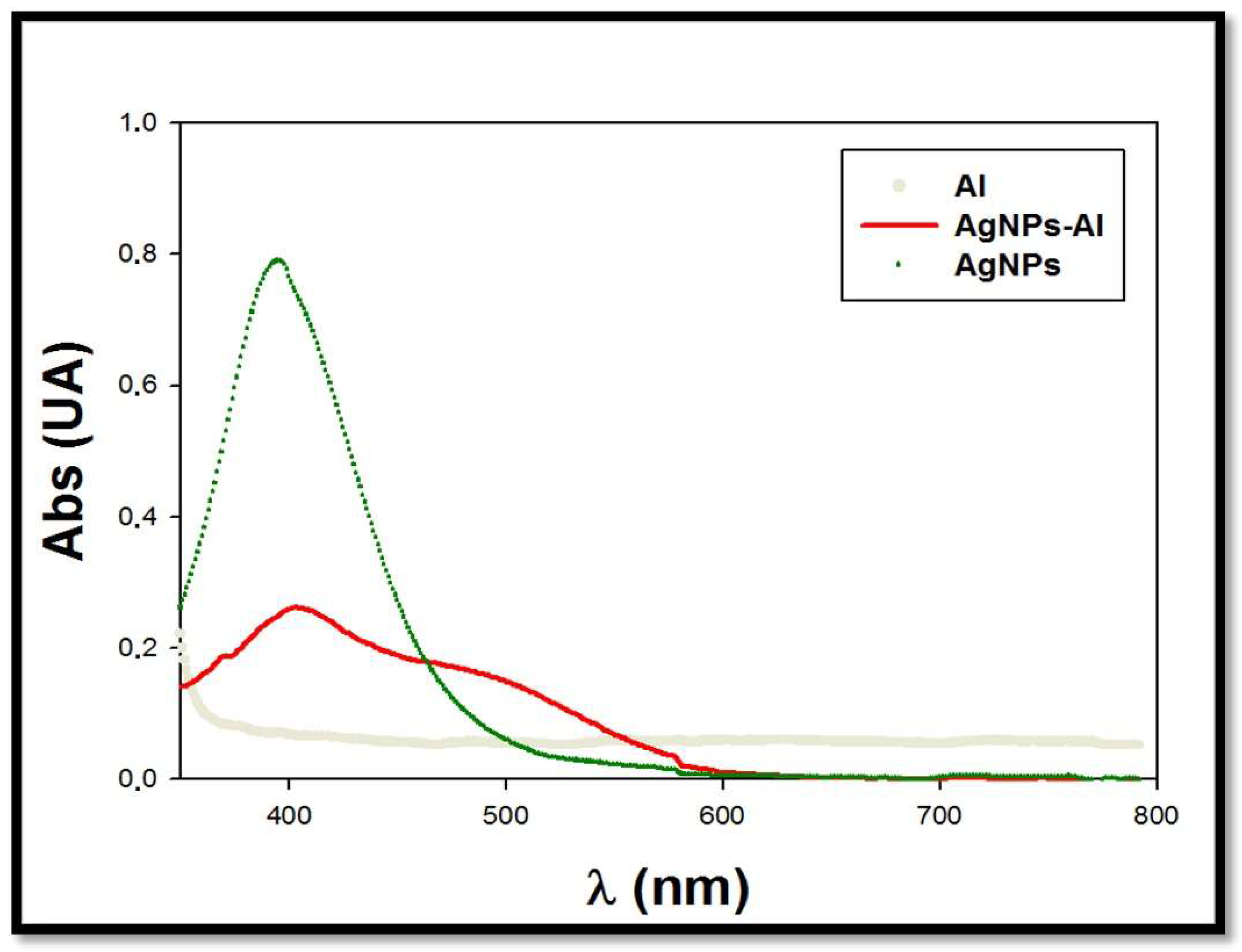
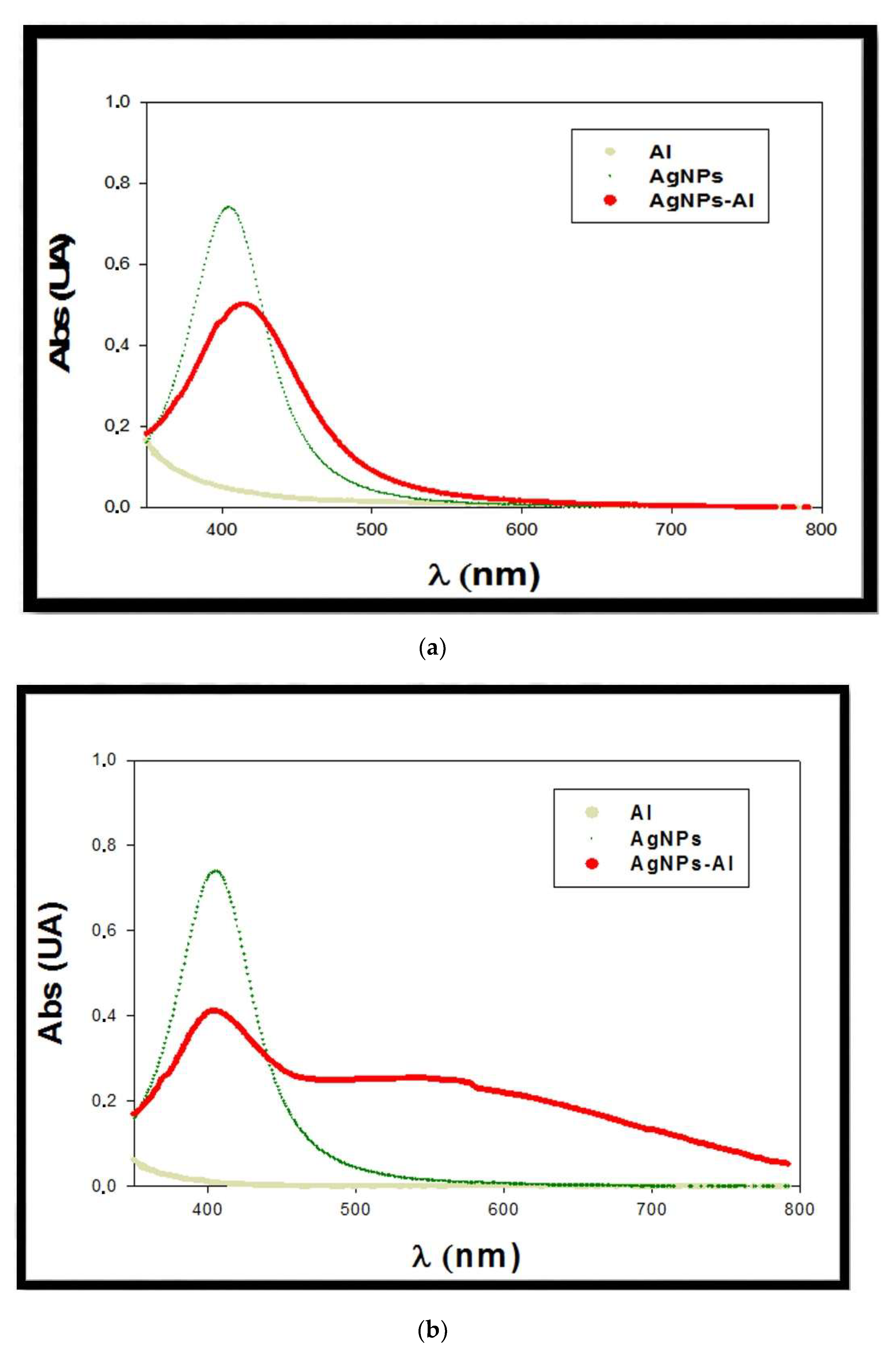
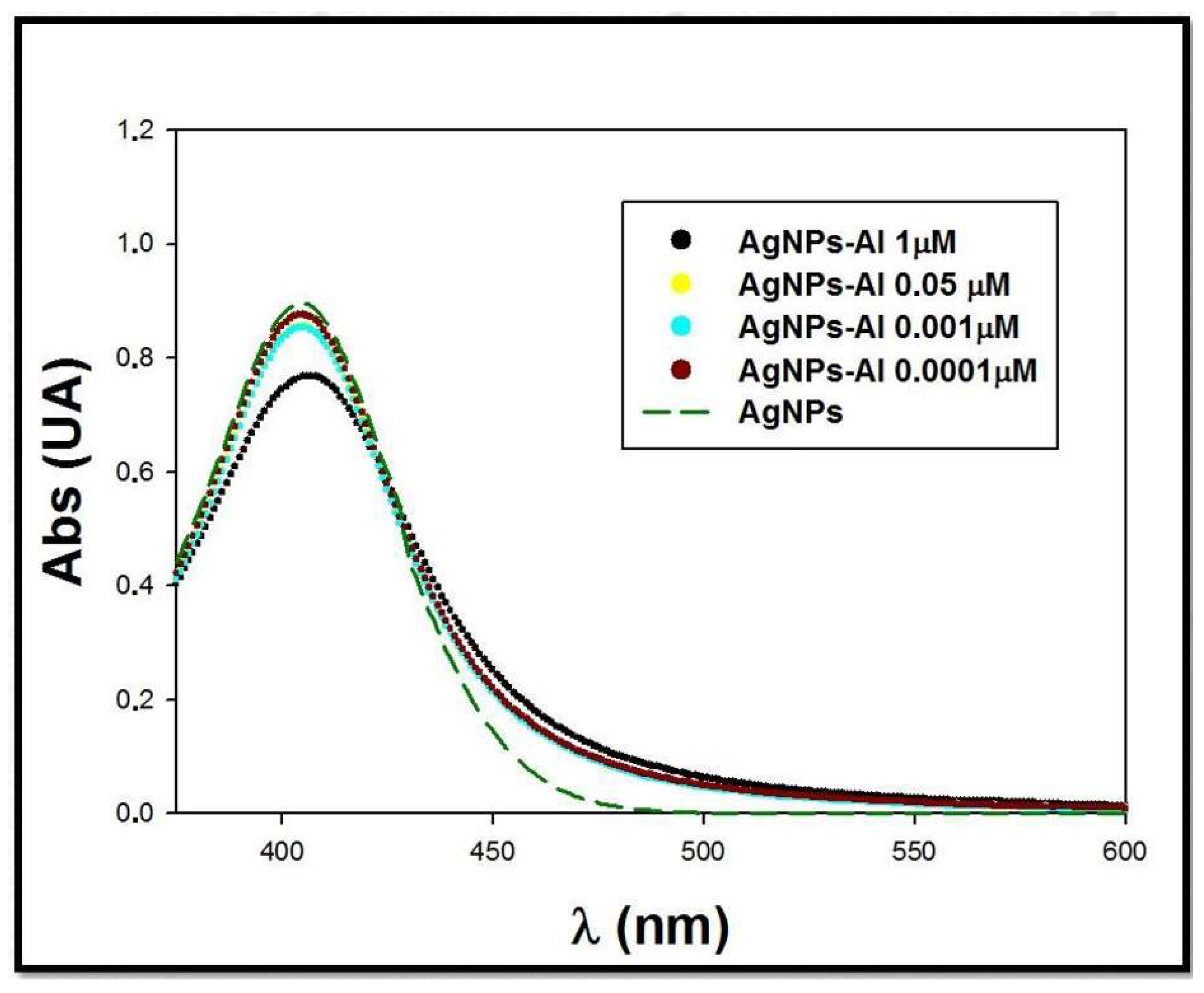
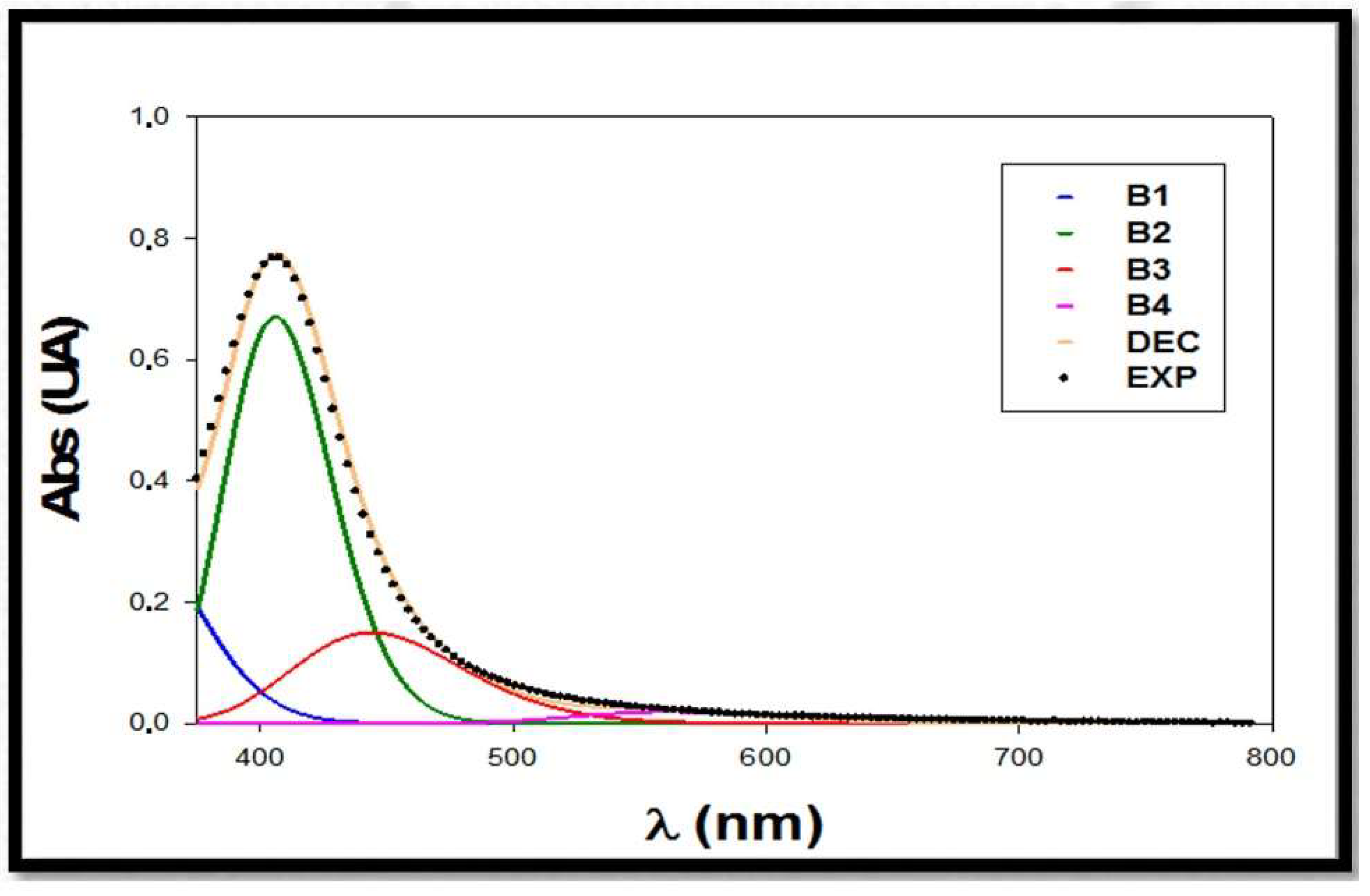
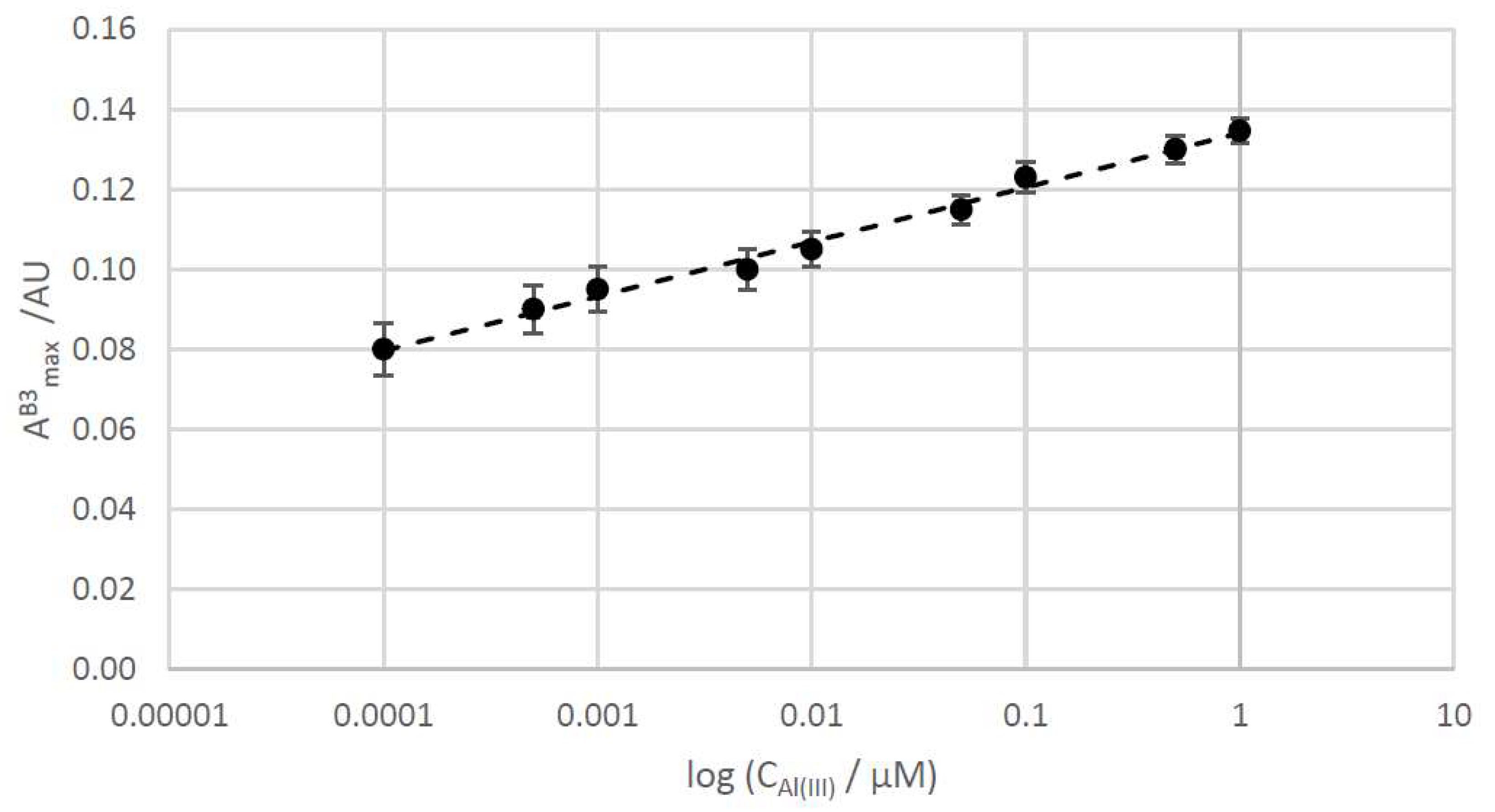
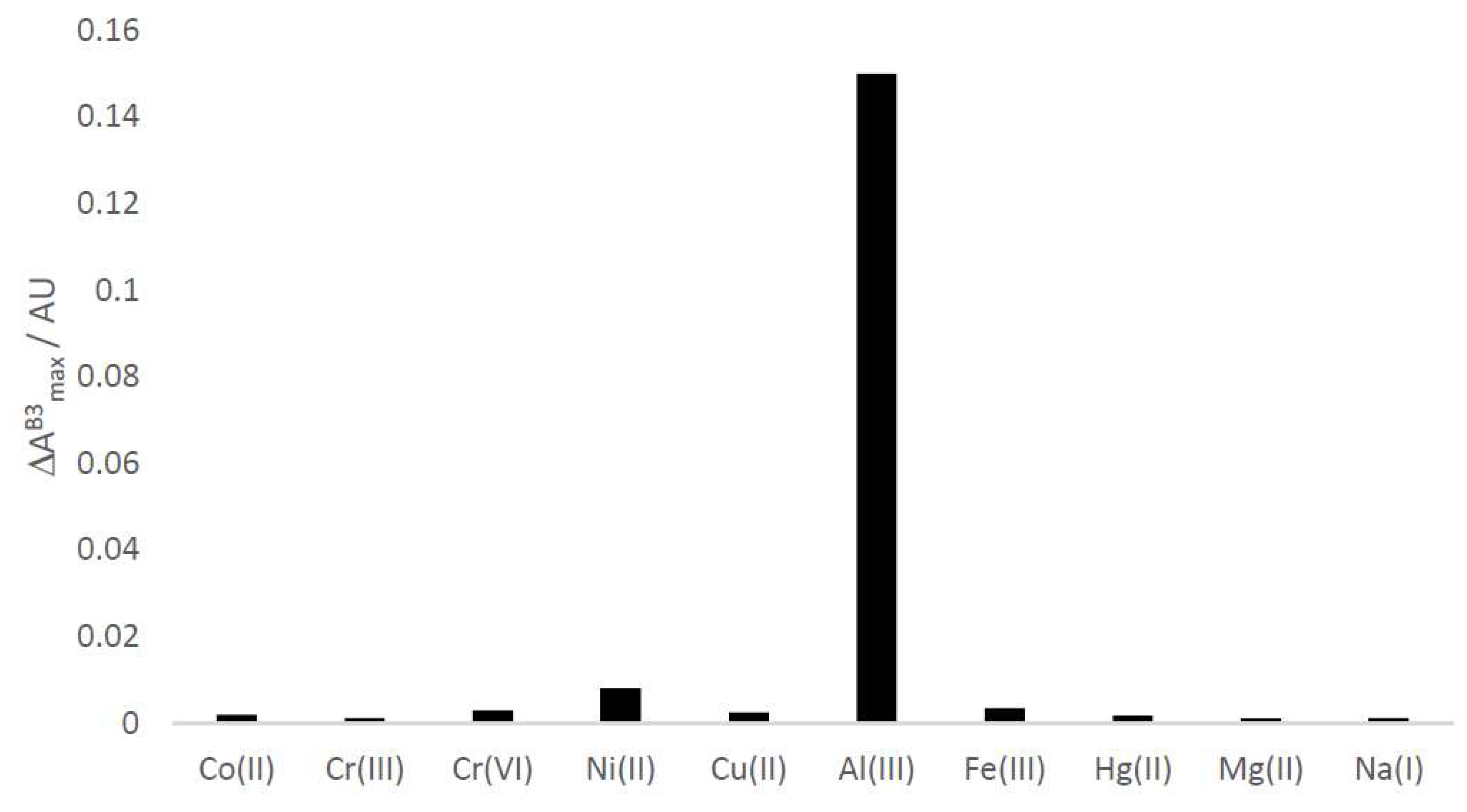
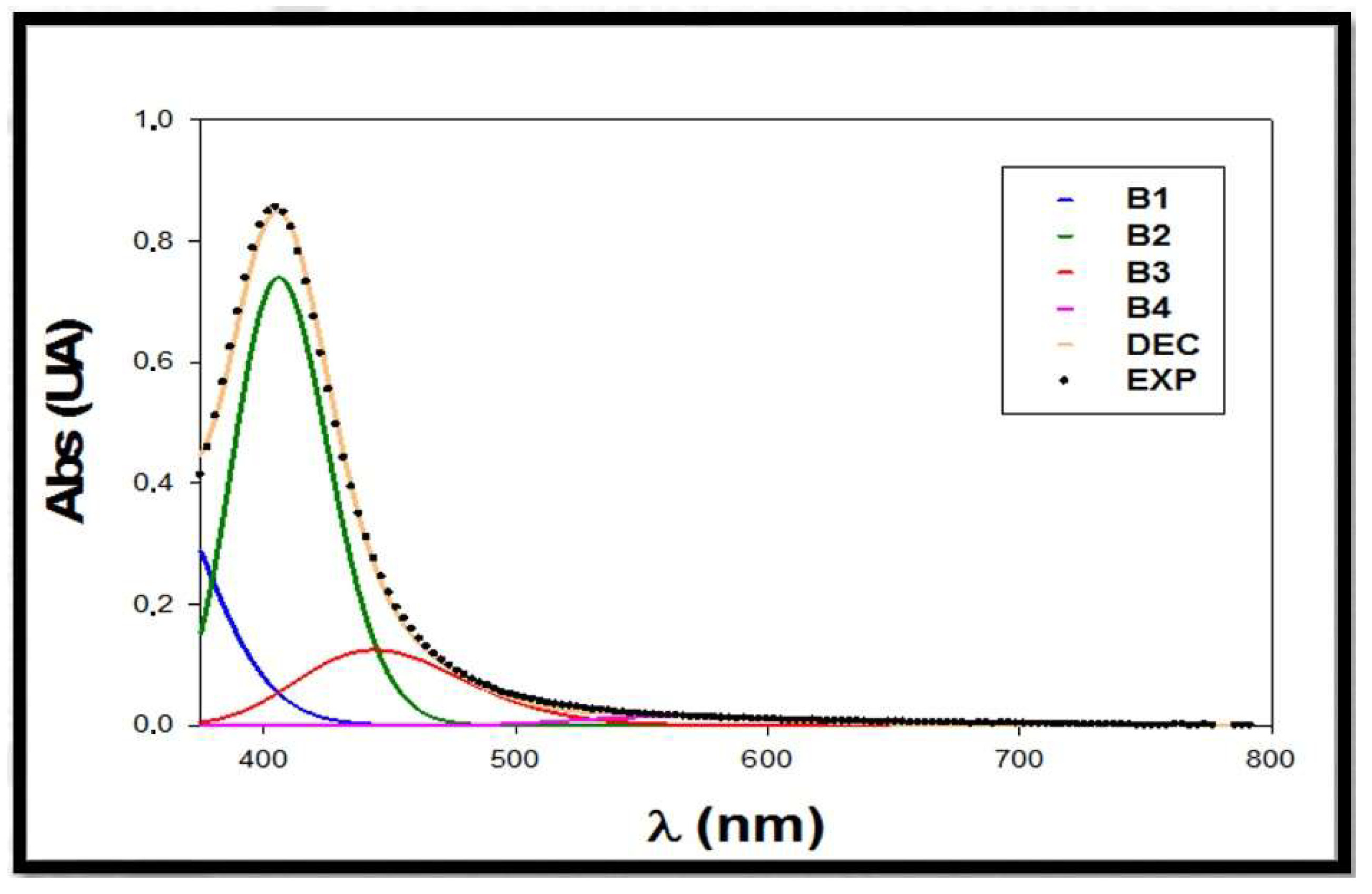
| Silver Nanoparticle | Shape | Medium Size (nm) | λmax (nm) |
|---|---|---|---|
| PVP-AgNPs | spherical | 10–20 | 424 |
| NaBH4-AgNPs | spherical | 2–4 | 392 |
| Citrate-AgNPs | spherical | 12–26 30–60 | 424 |
| Citrate+PVP-AgNPs | spherical | 10–20 25–45 | 397 |
| Al(III) (μM) in Mixtures | B2 | B3 | |||
|---|---|---|---|---|---|
| Amax (U.A.) | wv (kK) | Amax (U.A.) | wv (kK) | ||
| 1 | 0.670 | 3.0 | 0.150 | 4.0 | 0.22 |
| 0.5 | 0.690 | 2.7 | 0.140 | 3.9 | 0.20 |
| 0.1 | 0.700 | 2.7 | 0.135 | 3.9 | 0.19 |
| 5 × 10−2 | 0.740 | 2.7 | 0.125 | 3.9 | 0.17 |
| 1 × 10−2 | 0.753 | 2.7 | 0.120 | 3.9 | 0.16 |
| 5 × 10−3 | 0.760 | 2.7 | 0.110 | 3.9 | 0.14 |
| 1 × 10−3 | 0.765 | 2.9 | 0.105 | 4.0 | 0.13 |
| 5 × 10−4 | 0.770 | 2.9 | 0.095 | 4.4 | 0.12 |
| 1 × 10−4 | 0.775 | 3.1 | 0.090 | 4.4 | 0.11 |
| Probe | 102 LOD (μM) | 102 LOQ (μM) | Reference |
|---|---|---|---|
| Citrate+PVP-AgNPs | 4.05 | 13.5 | This work |
| Alizarin red S-AgNPs | 12 | 40.0 | [4] |
| Silver-gold alloy nanoclusters | 80 | 266.4 | [45] |
| Silver nanoclusters | 10 | 33.3 | [30] |
| Schiff base-functionalized AuNPs | 29 | 96.6 | [46] |
| Surface functionalized AuNPs | 6.7 | 22.3 | [47] |
| 8-hydroxyquinoline-5-sulfonate-AgNPs | 0.2 | 0.666 | [48] |
| Sample | Al(III) Added (μM) | Al(III) Observed (μM) * Citrate+PVP-AgNPs | Recovery (%) | Al(III) Observed (μM) * ICP-MS |
|---|---|---|---|---|
| Tap water | 0 | 0.23 ± 0.05 | - | 0.22 ± 0.03 |
| 0.5 | 0.82 ± 0.04 | 112 | 0.79 ± 0.02 | |
| 1 | 1.3 ± 0.1 | 106 | 1.4 ± 0.2 | |
| Pond water | 0 | 0.4 ± 0.1 | - | 0.3 ± 0.2 |
| 0.5 | 1.02 ± 0.08 | 113 | 1.06 ± 0.06 | |
| 1 | 1.6 ± 0.2 | 107 | 1.4 ± 0.3 | |
| River water | 0 | 0.56 ± 0.08 | - | 0.60 ± 0.03 |
| 0.5 | 1.05 ± 0.05 | 99 | 1.02 ± 0.06 | |
| 1 | 1.5 ± 0.1 | 96 | 1.7 ± 0.1 | |
| Mineral water | 0 | 0.16 ± 0.07 | - | 0.14 ± 0.04 |
| 0.5 | 0.8 ± 0.2 | 106 | 0.7 ± 0.2 | |
| 1 | 0.14 ± 0.03 | 98 | 0.16 ± 0.05 |
© 2020 by the authors. Licensee MDPI, Basel, Switzerland. This article is an open access article distributed under the terms and conditions of the Creative Commons Attribution (CC BY) license (http://creativecommons.org/licenses/by/4.0/).
Share and Cite
Ruíz del Portal-Vázquez, P.; López-Pérez, G.; Prado-Gotor, R.; Román-Hidalgo, C.; Martín-Valero, M.J. Citrate and Polyvinylpyrrolidone Stabilized Silver Nanoparticles as Selective Colorimetric Sensor for Aluminum (III) Ions in Real Water Samples. Materials 2020, 13, 1373. https://doi.org/10.3390/ma13061373
Ruíz del Portal-Vázquez P, López-Pérez G, Prado-Gotor R, Román-Hidalgo C, Martín-Valero MJ. Citrate and Polyvinylpyrrolidone Stabilized Silver Nanoparticles as Selective Colorimetric Sensor for Aluminum (III) Ions in Real Water Samples. Materials. 2020; 13(6):1373. https://doi.org/10.3390/ma13061373
Chicago/Turabian StyleRuíz del Portal-Vázquez, Paula, Germán López-Pérez, Rafael Prado-Gotor, Cristina Román-Hidalgo, and María Jesús Martín-Valero. 2020. "Citrate and Polyvinylpyrrolidone Stabilized Silver Nanoparticles as Selective Colorimetric Sensor for Aluminum (III) Ions in Real Water Samples" Materials 13, no. 6: 1373. https://doi.org/10.3390/ma13061373
APA StyleRuíz del Portal-Vázquez, P., López-Pérez, G., Prado-Gotor, R., Román-Hidalgo, C., & Martín-Valero, M. J. (2020). Citrate and Polyvinylpyrrolidone Stabilized Silver Nanoparticles as Selective Colorimetric Sensor for Aluminum (III) Ions in Real Water Samples. Materials, 13(6), 1373. https://doi.org/10.3390/ma13061373







